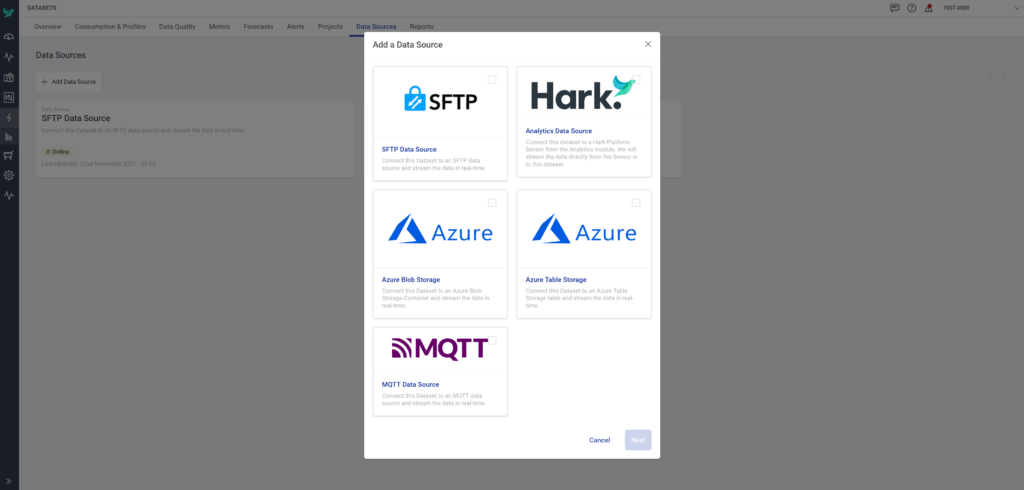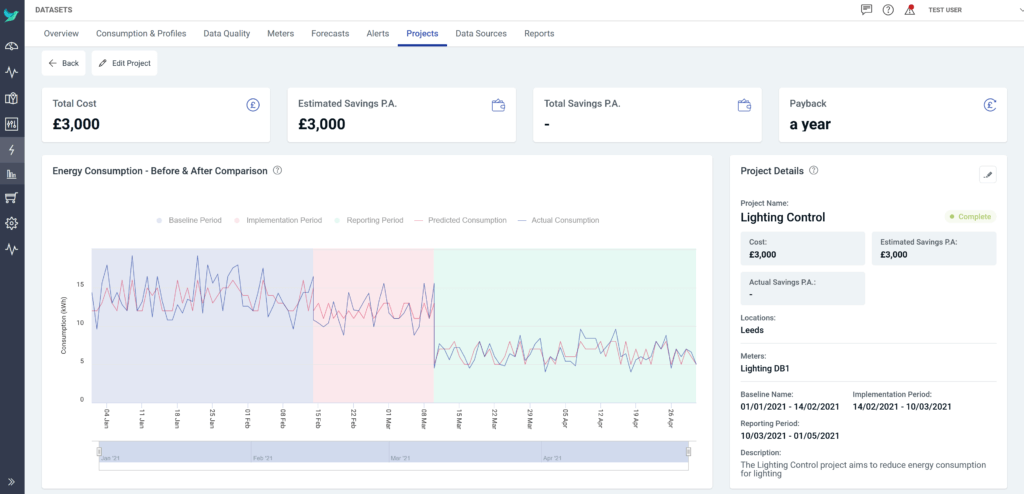Industrial Internet of Things
IoT is becoming more widespread across industrial settings. Visibility and connectivity of assets can provide many benefits to businesses looking to improve efficiency, reduce waste, or maximise yield. It can provide large time-saving opportunities, reducing the need for manual data collection and validation. However, having access to large amounts of data is not always the solution to a problem. Data must be utilised correctly; else we may only make the proverbial haystack larger! Using modern technologies like The Hark Platform, we can automatically identify Energy Savings Opportunities.
ISO 50001 & Significant Energy Uses
ISO 50001 is the gold standard for showcasing your commitment to the continual improvement of energy performance. Companies around the globe aim for certification by implementing an Energy Management System (EnMS) and proving its effectiveness.
There are multiple requirements for an EnMS to be certified, one of which is the identification, monitoring, and improvement of Significant Energy Uses (SEUs).
The formal definition of SEUs is that they account for substantial consumption of energy within a particular scope, and they offer considerable potential for energy performance improvement. The criteria for substantial, and the scope, can be defined by the organisation.
In simpler terms, these are the largest consumers of energy (SEU) within a location (scope). A consumer of energy could be equipment, a process, a system, or a facility. A location could be a process, a system, a facility, or the entire estate.
For example, within your home (your estate), significant energy uses could be your oven (equipment), making a cup of tea (a process), your heating, ventilation, and cooling (a system), or even your kitchen (a facility).
The importance of identifying SEUs
The benefit of defining and monitoring your SEUs is closely linked to the Pareto Principle. This principle specifies:
For many outcomes, roughly 80% of the consequences come from 20% of the causes.
This means that in a lot of situations, decreasing the usage of a major energy consumer can have a more substantial impact than improving several smaller consumers. This allows Continuous Improvement teams to focus their limited time on the areas that will have the largest effect. Therefore, SEUs form an important cornerstone of the ISO 50001 standard.
Define your Scope
Before you can think about which equipment, processes, systems, or facilities to designate as SEUs, you must first recognise which area of your estate you will be looking at. Identifying SEUs requires analysis and verification, so you will want to ensure you will have access to data that is granular enough.
For example, if your scope is a volatile low-level process (making a cup of tea) you need to have access to high granularity data (minutely energy consumption) as the SEUs will be of a low level (the kettle, fridge, lighting). If your scope is a stable high-level estate (your home) less granular data is required (energy consumption over a large interval) as the SEUs can also be of a high level (the kitchen, bedroom, etc). Within your scope, SEUs should all be at a similar level; there’s not much value in comparing a bedroom to a kettle!
Having complete awareness of your energy estate can make it simple to identify the best scope to work at. This can be done manually using supplier bill data, manual meter readings that requires substantial time and effort. Alternatively, you can use the Hark Platform to connect to a wide variety of existing energy assets and protocols, and automatically send minutely readings to the cloud. This is one of the strengths of IIoT, as it allows you to focus on making important decisions; not manually collecting data.

An effective way of ensuring everything is accurately accounted for within your estate, is by creating an Energy Balance. This works by confirming that the consumption of your estate is similar (usually ±5%) to the sum of its parts. It guarantees that nothing has been missed, so SEUs can be identified reliably.
For example, if your home consumes 300kWh/month, your energy balance may look something like this:
| Facility | Monthly kWh consumption |
| Living Room | 80 kWh |
| Kitchen | 130 kWh |
| Bedroom | 50 kWh |
| Bathroom | 20 kWh |
| Hallway | 15 kWh |
| Total | 295 kWh |
As the facility total is within ±5% of the estate total, we would accept this energy balance as it covers the majority of the estate. Anything missed can be deemed insignificant.
If we were to produce an energy balance on a lower level, it may look something like this:
| Equipment | Monthly kWh consumption |
| Living Room – Lighting | 10 kWh |
| Living Room – Heating | 50 kWh |
| Living Room – TV | 5 kWh |
| Kitchen – Oven | 40 kWh |
| Kitchen – Lighting | 20 kWh |
| Kitchen – Heating | 60 kWh |
| Kitchen – Kettle | 10 kWh |
| Kitchen – Microwave | 10 kWh |
| Bedroom – Lighting | 10 kWh |
| Bathroom – Heating | 15 kWh |
| Hallway – Heating | 5 kWh |
| Total | 235 kWh |
As the equipment total is outside ±5% of the estate total, we would need to improve the data collection for this energy balance. However, we could reduce our scope to focus on the kitchen, as we have enough data to fall within the Energy Balance requirements.
At this level of granularity, it’s hard to have access to data for all consumers of energy. There is a wide range of smaller appliances we may have missed – outdoor lighting, charging mobile devices, games consoles, etc. The Hark Platform guarantees nothing falls through the cracks and can easily notify you if any change in consumption is unaccounted for within an Energy Balance.
Identifying SEUs
Now that we have access to reliable energy data, we are well on the way to determining our estate’s Significant Energy Uses! The next step is to define the criteria for significance.
Most organisations would simply select the largest consumers from the Energy Balance, as these generally offer the largest opportunities for savings. However, if you have a mature Energy Management System, other factors may come into play.
SEUs aim to assist organisations in deciding which efficiency projects they should implement, so this should be at the forefront of your significance criteria. If you have implemented efficiency projects recently, it may be better to focus on smaller equipment or facilities that have greater opportunities. Organisations may also define their criteria based on carbon emissions, safety concerns, process criticality, and anything else that can impact the efficiency project decision process.
For example, within your kitchen, you can see the largest consumer of energy is the heating. You may select this as an SEU as you know your insulation could be improved, and hence a large opportunity for savings. However, you may avoid including the next largest consumer, your oven, as an SEU, as you know you have already recently upgraded it to a more efficient version, meaning there is little room for savings.
Now we understand the criteria of what makes an SEU significant, we can determine which equipment, processes, systems, or facilities to focus on for efficiency projects.
Monitoring SEUs and Identifying Opportunities
After we have defined a list of SEUs to target, we can begin the monitoring phase. If your EnMS is mature, you may already have access to a good amount of historical data. If not, the best time to start collecting it is now.
We should begin by considering the relevant variables that affect SEUs and calculate their Energy Performance Indicators (EnPI – you can learn more about EnPI here). Considering how external factors affect SEUs is vital to selecting the most appropriate and effective efficiency project.
For example, the EnPI for your kitchen heating would likely use degree days. By looking at how the EnPI has changed over time you could determine which efficiency project has the greatest opportunity for savings. If consumption remains high regardless of degree days, it may be worth improving the heating timer or thermostat. If consumption increases with degree days, it may be worth improving the kitchen insulation.
We can automatically account for multiple affecting factors by using the Hark Platform’s Energy Index tool, which normalises performance by external metrics, and recommends the optimal areas for improvement.
Implementing Changes and Verifying Their Impact
Now that we have decided which projects will have the greatest impact on our Significant Energy Uses, we can implement them! This could be anything that will improve energy efficiency such as fitting LED bulbs, replacing old equipment, improving process timings, and more.
When making any changes to your SEUs, it is vital to monitor and verify their impact correctly. Typically, this involves a comparison before, during, and after implementation, normalised by any external factors. This process is known as baselining (you can read more about Energy Baselining here). Energy Baselines aim to prove an increase in efficiency and is also a necessary stage for ISO 50001 certification. It also helps the organisation understand the costs and payback time of the project, as it may be replicable across the rest of the estate.
The Hark Project Verification tool provides a convenient place to track all your projects, and automatically calculate savings and paybacks, producing the required documentation required for ISO 50001.


Conclusion
Defining and analysing SEUs is not only a requirement for ISO 50001 certification but can also help you to uncover significant opportunities to reduce your energy costs and carbon emissions. This process requires continual improvement by frequently updating your chosen SEUs and planning and implementing the next efficiency project.
If you’d like to learn more about any of the tools mentioned, or would like to see how we can help you get ISO 50001 certified, get in touch at hello@harksys.com.



